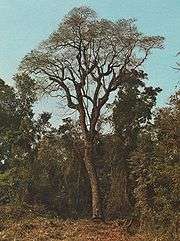Balsam
Balsam is the resinous exudate (or sap), which forms on certain kinds of trees and shrubs. Balsam (from Hebrew bosem בֹּשֶׂם, "spice", "perfume") owes its name to the biblical Balm of Gilead.

Chemistry
Balsam is a solution of plant-specific resins in plant-specific solvents (essential oils). Such resins can include resin acids, esters, or alcohols. The exudate is a mobile to highly viscous liquid and often contains crystallized resin particles. Over time and as a result of other influences the exudate loses its liquidizing components or gets chemically converted into a solid material (i.e. by autoxidation).[1]
Some authors require balsams to contain benzoic or cinnamic acid or their esters.[2][3] Plant resins are sometimes classified according to other plant constituents in the mixture, for example as:[2]
- pure resins (guaiac, hashish),
- gum-resins (containing gums/polysaccharides),
- oleo-gum-resins (a mixture of gums, resins and essential oils),
- oleo-resins (a mixture of resins and essential oils, e. g. capsicum, ginger and aspidinol),
- balsams (resinous mixtures that contain cinnamic and/or benzoic acid or their esters),
- glycoresins (podophyllin, jalap, kava kava),
- fossile resins (amber, asphaltite, Utah resin).
Usually, animal secretions (musk, shellac, beeswax) are excluded from this definition.
List of balsams
- Acaroid resin (Xanthorrhoea sp.)
- Acouchi balsam (Protium sp.)
- Ammoniacum
- Asafoetida (Laser)
- Balm of Gilead
- Balm of Mecca
- Balsam of Peru
- Balsam of Tolu
- Bisabol
- Bdellium
- Benzoin resin
- Bukhoor
- Cabreuva balsam (Myrocarpus frondosus, Myrocarpus fastigatus)
- Camphor
- Canada balsam
- Chinese lacquer (Japanese lacquer)
- Copaiba balsam
- Copal
- Corneiba balsam (Schinus terebinthifolius or Lithraea brasiliensis)
- Damar
- Dragon's blood (Calamus draco)
- Elemi
- Frankincense (Olibanum)
- Galbanum
- Guayac (Guaiacum officinale)
- Guggul
- Gurjun balsam
- Imbauba balsam (Cecropia adenopus)
- Labdanum
- Mastic
- Myrrh
- Obira balsam (Apocynaceae)
- Opopanax
- Umiri balsam (Humiria floribunda)
- Rosin (Colophony)
- Sagapenum
- Sandarac
- Sarcocolla
- Styrax balsam
- Turpentine
- Venice turpentine (Larch turpentine) (Larix europaea)
- Wallaba balsam (Eperua sp.)
Safety
Some balsams, such as Balsam of Peru, may be associated with allergies. In particular, Euphorbia latex ("wolf's milk") is strongly irritant and cytotoxic.
See also
References
- ↑ Klemens Fiebach; Dieter Grimm (2007), "Resins, Natural", Ullmann's Encyclopedia of Industrial Chemistry (7th ed.), Wiley, p. 2
- 1 2 Andrew Pengelly (2004), "Essential oils and resins", The constituents of medicinal plants (2nd ed.), Allen & Unwin, p. 102
- ↑
 "Balsam". Encyclopædia Britannica. 3 (11th ed.). 1911.
"Balsam". Encyclopædia Britannica. 3 (11th ed.). 1911.